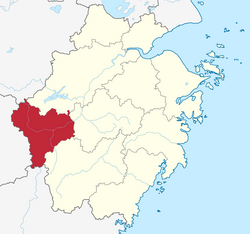
Confucius, born Kong Qiu (孔丘) was a Chinese philosopher of the Spring and Autumn period who is traditionally considered the paragon of Chinese sages. Confucius's teachings and philosophy underpin the East Asian culture and society, and remain influential across China and East Asia to this day. His philosophical teachings, called Confucianism, emphasized personal and governmental morality, correctness of social relationships, justice, kindness, sincerity, and a ruler's responsibilities to lead by virtue.

Shandong is a coastal province of the People's Republic of China and is part of the East China region.

Qufu is a city in southwestern Shandong province, East China. It is located about 130 kilometres (81 mi) south of the provincial capital Jinan and 45 km (28 mi) northeast of the prefectural seat at Jining. Qufu has an area of 815 square kilometers, and a total population of 653,000 inhabitants, of which, 188,000 live in urban areas.
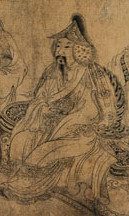
Toghon Temür, also known by his temple name as the Emperor Huizong of Yuan bestowed by the Northern Yuan dynasty and by his posthumous name as the Emperor Shun of Yuan bestowed by the Ming dynasty, was the last emperor of the Yuan dynasty and later the first emperor of the Northern Yuan dynasty. Apart from Emperor of China, he is also considered the last Khagan of the Mongol Empire. He was a son of Kusala.

Kung Te-cheng was a 77th generation descendant of Confucius in the main line of descent. He was the final person to be appointed Duke Yansheng and the first Sacrificial Official to Confucius. He helped formulate and was in charge of officiating the modern Confucius ceremony held annually in the Republic of China (Taiwan). In addition to Ceremonial Official, he held numerous posts in the Republic of China government, including member of the National Assembly from 1946 to 1991, President of the Examination Yuan from 1984 to 1993, and senior advisor to the President of the Republic of China from 1948 to 2000. He held professorships at National Taiwan University, Fu Jen Catholic University, and Soochow University.

Jinhua, alternately romanized as Kinhwa, is a prefecture-level city in central Zhejiang province in eastern China. It borders the provincial capital of Hangzhou to the northwest, Quzhou to the southwest, Lishui to the south, Taizhou to the east, and Shaoxing to the northeast. Its population was 7,050,683 as of the 2020 census including 1,463,990 in the built-up area made of two urban districts.
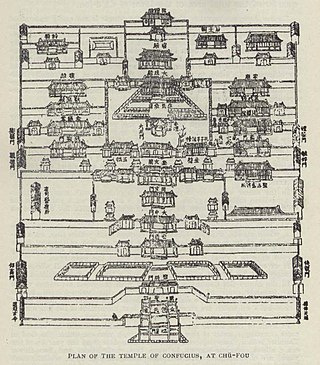
A temple of Confucius or Confucian temple is a temple for the veneration of Confucius and the sages and philosophers of Confucianism in Chinese folk religion and other East Asian religions. They were formerly the site of the administration of the imperial examination in China, Korea, Japan and Vietnam and often housed schools and other studying facilities.
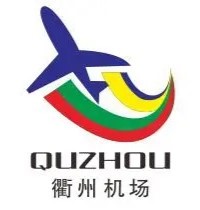
Quzhou Airport, also called Quzhou Air Base is a dual-use military and civil airport located 2.9 kilometers east of the city of Quzhou in Zhejiang Province, China. Originally only a military airfield for the People's Liberation Army Air Force, the airport was first expanded for use by American bombers during World War II, and was later occupied by Japanese troops. A small passenger terminal opened to commercial flights on 26 November 1993, though expanded commercial use of the airport has been hampered by continued heavy military presence due to the airport's proximity to the East China Sea and Taiwan Strait. Airlines operating out of Quzhou Airport generally operate medium to large narrow-body aircraft, such as the Boeing 737. Quzhou's commercial passenger terminal is unique in being separated from the airport's two aircraft bays by a lake, requiring passengers to walk across a lengthy causeway before boarding. The airport serves as the base of operations for regional carrier Quzhou Airlines.

The Duke Yansheng, literally "Honorable Overflowing with Wisdom", sometimes translated as Holy Duke of Yen, was a Chinese title of nobility. It was originally created as a marquis title in the Western Han dynasty for a direct descendant of Confucius.
Kong is a Chinese and Korean surname. It can also be written as Kung in Taiwan, Hung in Hong Kong, Khổng in Vietnam, and Gong in Korea. There are around 2.1 million people with this surname in China in 2002, representing 0.23% of the population. In 2018, it was the 97th-most common surname in China. It is the 25th name in the Hundred Family Surnames poem.
This is a family tree of the main line of descent of Confucius.

The Temple of Yan Hui, commonly known as simply the Temple of Yan or Yan Temple, is a temple in Qufu, China, dedicated to Yan Hui, the favorite disciple of Confucius.
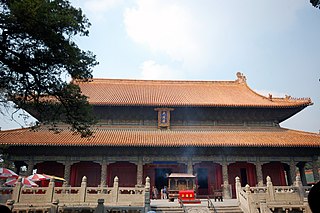
The Temple of Confucius in Qufu, Shandong Province, is the largest and most renowned temple of Confucius in East Asia.

The Cemetery of Confucius is a cemetery of the Kong clan in Confucius' hometown Qufu in Shandong province. Confucius himself and some of his disciples are buried there, as well as many thousands of his descendants.

The Kong Family Mansion was the historical residence of the direct descendants of Confucius in the City of Qufu, the hometown of Confucius in Shandong Province, China. The extant structures mainly date from the Ming and Qing dynasties. From the mansion, the family tended to the Confucian sites in Qufu and also governed the largest private rural estate in China. The Kong family was in charge of conducting elaborate religious ceremonies on occasions such as plantings, harvests, honoring the dead, and birthdays. Today, the mansion is a museum and part of the UNESCO World Heritage Site "Temple and Cemetery of Confucius and the Kong Family Mansion in Qufu".

Kong Anguo, courtesy name Ziguo (子國), Kong Anguo was a Chinese classicist, philosopher, and politician of the Western Han dynasty of ancient China. A descendant of Confucius, he wrote the Shangshu Kongshi Zhuan, a compilation and commentary of the "Old Text" Shangshu. His work was lost, but a debated fourth-century forgery was officially recognized as a Confucian classic for over a millennium.
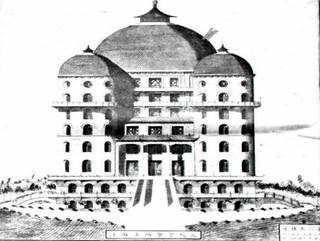
The Confucian church is a Confucian religious and social institution of the congregational type. It was first proposed by Kang Youwei (1858–1927) near the end of the 19th century, as a state religion of Qing China following a European model.
The Holy Confucian Church or Holy Church of Confucius or Holy Confucian Church of China is a religious organisation of Confucianism in China, formed by local Confucian churches or halls. A grassroots movement of local Confucian churches was initiated in 2009 by Zhou Beichen, a disciple of the Confucian philosopher Jiang Qing, when he founded the first church in Shenzhen, The aim was to develop a network of local Confucian churches throughout the country, later to be unified into a national body and possibly become a state religion in China. The national and international body, the Holy Confucian Church of China, was established in late 2015.
The Gokbu Gong clan is one of the Korean clans originally from China. Their Bon-gwan are in Qufu, Shandong in China, which was also Confucius's birthplace. Qufu is known as Gokbu (Korean: 곡부) in Korean. According to the South Korean 2000 census, the number of individuals identifying with the Gokbu Gong clan was 74,135. The apical ancestor of the clan was Confucius.

The Taichung Confucian Temple is a Confucian temple in North District, Taichung, Taiwan.


